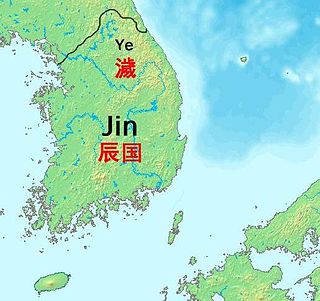Related Research Articles

The Three Kingdoms of Korea refers to the three kingdoms of Goguryeo, Baekje, and Silla. Goguryeo was later known as Goryeo, from which the modern name Korea is derived. The Three Kingdoms period is defined as being from 57 BC to 668 AD.

Silla or Shilla was a Korean kingdom located on the southern and central parts of the Korean Peninsula. Silla, along with Baekje and Goguryeo, formed the Three Kingdoms of Korea.

Gaya was a Korean confederacy of territorial polities in the Nakdong River basin of southern Korea, growing out of the Byeonhan confederacy of the Samhan period.

Geumgwan Gaya (43–532), also known as Bon-Gaya or Garakguk, was the ruling city-state of the Gaya confederacy during the Three Kingdoms Period in Korea. It is believed to have been located around the modern-day city of Gimhae, Southern Gyeongsang province, near the mouth of the Nakdong River. Due to its geographic location, this kingdom played a dominant role in the regional affairs from the Byeonhan period onward to the end of the Gaya confederacy.

Ara Gaya, also known as Ana Gaya, Asiryangguk ), and Anra,Alla, was a city-state kingdom in the part of Gaya confederacy, in modern-day Haman County of South Korea. As the confrontational foreign policy of Daegaya failed, Ara Gaya and its less confrontational policy gained support in the 540s AD.

Byeonhan, also known as Byeonjin, was a loose confederacy of chiefdoms that existed from around the beginning of the Common Era to the 4th century in the southern Korean peninsula. Byeonhan was one of the Samhan, along with Mahan and Jinhan.

Mahan was a loose confederacy of statelets that existed from around the 1st century BC to 5th century AD in the southern Korean peninsula in the Chungcheong and Jeolla provinces. Arising out of the confluence of Gojoseon migration and the Jin state federation, Mahan was one of the Samhan, along with Byeonhan and Jinhan. Baekje began as a member statelet, but later overtook all of Mahan and became one of the Three Kingdoms of Korea.
Gaya may refer to:
Jinhan was a loose confederacy of chiefdoms that existed from around the 1st century BC to the 4th century AD in the southern Korean Peninsula, to the east of the Nakdong River valley, Gyeongsang Province. Jinhan was one of the Samhan, along with Byeonhan and Mahan. Apparently descending from the Jin state of southern Korea, Jinhan was absorbed by the later Silla, one of the Three Kingdoms of Korea.

Bihwa Gaya, also known as Bijabal in Japanese records of the time, was one of the member states of the Gaya confederacy during the Three Kingdoms period of Korea. It was based near the modern-day city center of Changnyeong County in South Gyeongsang province, South Korea. It was conquered by Silla in the 6th century AD, some time before 555.

The state of Jin was a confederacy of statelets which occupied some portion of the southern Korean peninsula during the 2nd and 3rd centuries BCE, bordering the Korean kingdom Gojoseon to the north. Its capital was somewhere south of the Han River. It preceded the Samhan confederacies, each of which claimed to be successors of the Jin state.

Samhan, or Three Han, is the collective name of the Byeonhan, Jinhan, and Mahan confederacies that emerged in the first century BC during the Proto–Three Kingdoms of Korea, or Samhan, period. Located in the central and southern regions of the Korean Peninsula, the Samhan confederacies eventually merged and developed into the Baekje, Gaya, and Silla kingdoms. The name "Samhan" also refers to the Three Kingdoms of Korea.

Korea's military history spans thousands of years, beginning with the ancient nation of Gojoseon and continuing into the present day with the countries of North Korea and South Korea, and is notable for its many successful triumphs over invaders. Throughout its history, Korea has boasted numerous exceptional leaders who gained outstanding victories against numerically superior enemies. Famed leaders credited with defending Korea against foreign invasions include: Eulji Mundeok of Goguryeo, who defeated Sui China during the Goguryeo–Sui War; Yeon Gaesomun of Goguryeo, who defeated Emperor Taizong of Tang China during the Goguryeo–Tang War; Gang Gam-chan of Goryeo, who defeated the Khitan Empire during the Goryeo-Khitan War; Choe Yeong and Yi Seong-gye of Goryeo, who defeated the Red Turbans, who later established Ming China, during the Red Turban Invasions; and Yi Sun-shin of Joseon, who defeated the Japanese at sea during the Imjin War. Other notable leaders include: Gwanggaeto the Great of Goguryeo, who created a great empire in Northeast Asia through conquest, and subjugated the other Korean kingdoms of Baekje, Silla and Gaya to bring about a brief unification of the Three Kingdoms of Korea; Geunchogo of Baekje, who captured Pyongyang and established overseas territories to control much of the Korean peninsula and dominate the seas; Munmu and Kim Yu-sin of Silla, who united the Three Kingdoms of Korea and defeated Tang China to gain complete control of the Korean peninsula; Dae Jo-yeong, who created Balhae from Goguryeo's ashes and reconquered Goguryeo lands lost during the Goguryeo-Tang War; Jang Bogo of Later Silla, who created a maritime empire and commanded a powerful fleet; Wang Geon, who united the Later Three Kingdoms of Korea and established Goryeo as the successor to Goguryeo; and Yun Gwan of Goryeo, who defeated the Jurchens and constructed nine fortresses in Manchuria.

The Proto–Three Kingdoms period refers to the proto-historical period in the Korean Peninsula, after the fall of Gojoseon and before the maturation of Goguryeo, Baekje, and Silla into full-fledged kingdoms. It is a subdivision of what is traditionally called Korea's Three Kingdoms Period and covers the first three centuries of the Common Era, corresponding to the later phase of the Korean Iron Age.
Pasa the great was the fifth ruler of Silla, one of the Three Kingdoms of Korea. He is commonly called Pasa Isageum, isageum being the royal title in early Silla. As a descendant of Silla's founder Hyeokgeose, his surname was Bak.
This is a partial list of Korea-related topics beginning with G. For Korean words starting with ㄱ, see also under K.
History of the Gaya Confederacy

The language of the kingdom of Baekje, one of the Three Kingdoms of Korea, is poorly attested, and scholars differ on whether one or two languages were used. However, at least some of the material appears to be variety of Old Korean.

Gaya, also rendered Kaya, Kara or Karak, is the presumed language of the Gaya confederacy in southern Korea. Only one word survives that is directly identified as being from the language of Gaya. Other evidence consists of place names, whose interpretation is uncertain.

The Han languages were the languages of the Samhan of ancient southern Korea, the confederacies of Mahan, Byeonhan and Jinhan. They are mentioned in surveys of the peninsula in the 3rd century found in Chinese histories, which also contain lists of placenames. There is no consensus about the relationships between these languages and with the languages of later kingdoms.
References
- ↑ According to Donggukyeojiseungram, it was destroyed during Yuri of Silla. According to Samguk Yusa, Iseo people attack capital in 37 CE. However, in Yurye of Silla 14th(297 CE), Iseoguk appeared on the record again. Due to these errors, Korean academic community sees it as a record error.
- ↑ This is recorded only in the Geodo(居道) biography of the Samguk Sagi. However, according to archaeology, the actual relics of Silla were not revealed until the early 5th century in Busan. Busan is presumed to be a Dongno(瀆盧國) of Byeonhan which still exist in late 3rd century. Due to these errors, Korean academic community does not understand the incident.